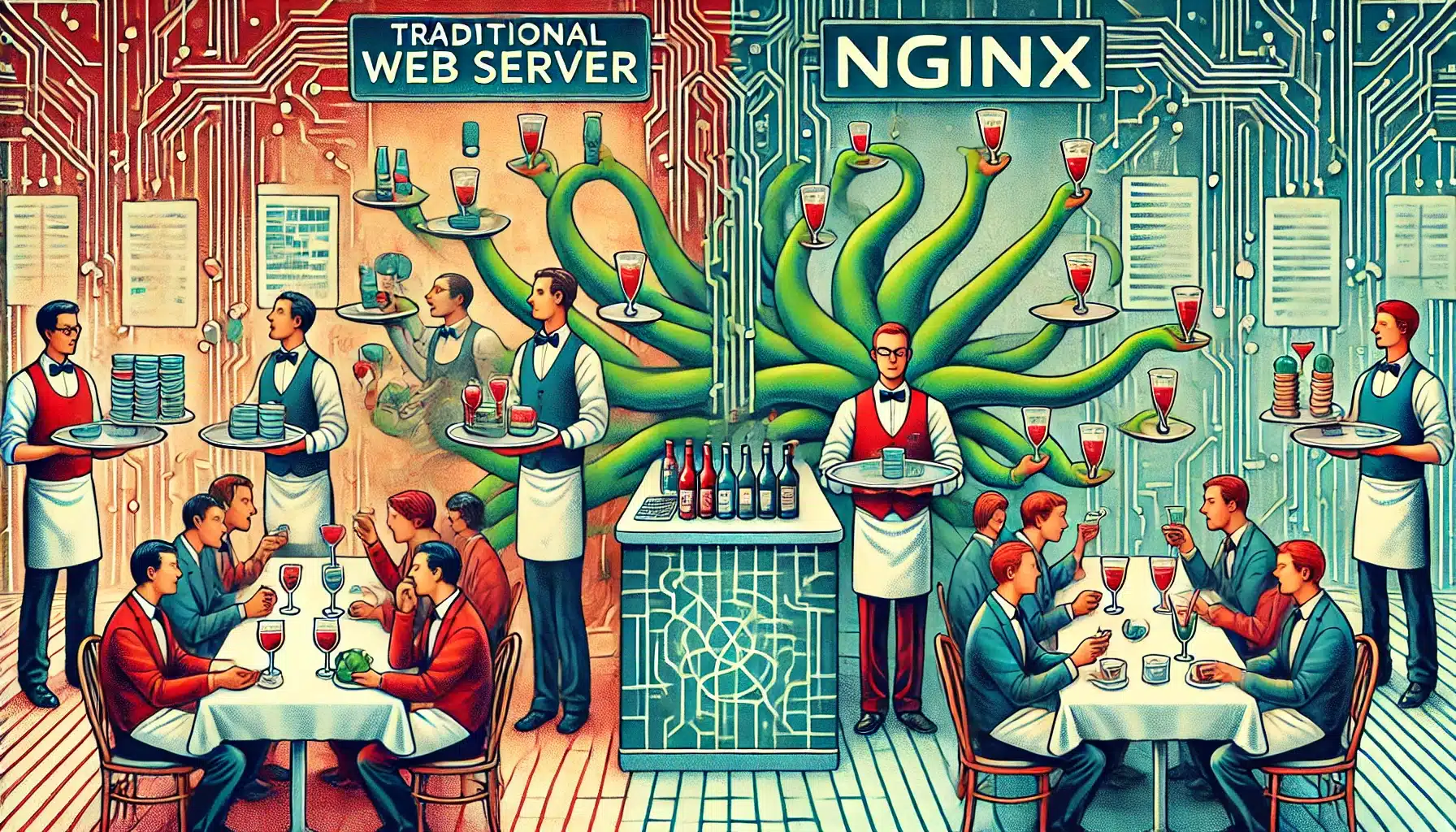In the world of web servers, Nginx stands out as a powerhouse of performance and efficiency. But what makes it so special? In this first part of our three-part series, we’ll dive into the core of Nginx’s magic: its event-driven architecture. Buckle up, because we’re about to turn some complex tech concepts into something a bit more digestible.
The Problem with Traditional Web Servers
To understand why Nginx is such a game-changer, we first need to look at the limitations of traditional web servers. Many older or more conventional servers use a process-per-connection or thread-per-connection model.
Imagine a busy restaurant where each waiter can only serve one table at a time. As more diners arrive, you need to hire more waiters. Soon, you’ve got a restaurant full of waiters bumping into each other, costs spiraling out of control, and a maitre d’ pulling their hair out trying to manage it all.
This is essentially what happens with traditional web servers under high load. Each new connection (a diner in our analogy) requires a new process or thread (a waiter). As traffic increases, the server spawns more processes, eating up RAM and CPU cycles. Eventually, the server reaches its limit and performance degrades rapidly.
Nginx’s Solution: Event-Driven Architecture
Enter Nginx, with its event-driven, asynchronous architecture. Instead of spawning a new process for each connection, Nginx uses an event loop to handle multiple connections within a single worker process.
Think of Nginx as a skilled bartender who can manage multiple drink orders simultaneously. They don’t stand idle waiting for one drink to be prepared before starting the next. Instead, they efficiently move between tasks, shaking one cocktail while pouring another and taking new orders, all without missing a beat.
This is the essence of Nginx’s event-driven model. It can juggle thousands of connections concurrently, switching between them as needed, all within a single thread.
The Master and Worker Processes
Nginx operates using a master process and several worker processes. The master process is like a head chef in a kitchen. It doesn’t do the actual cooking (or in Nginx’s case, doesn’t handle network connections), but it oversees everything. It reads the configuration, binds to ports, and creates worker processes.
The worker processes, like line cooks in our kitchen analogy, do the actual work of handling connections. Each worker can handle thousands of connections simultaneously, thanks to the event-driven model.
This separation of responsibilities allows Nginx to be both efficient and resilient. If a worker process crashes, the master can simply spawn a new one without disrupting service.
Non-Blocking I/O Operations
A key feature of Nginx’s architecture is its use of non-blocking I/O operations. This is crucial for handling many concurrent connections efficiently.
Imagine a juggler keeping multiple balls in the air. They don’t wait for one ball to return to their hand before throwing the next. Instead, they keep everything in constant motion, smoothly transitioning between balls.
Similarly, Nginx doesn’t wait for a slow I/O operation (like reading from disk or querying a database) to complete before moving on. It initiates the operation and then switches to handling other tasks while waiting for the I/O to complete. When the operation finishes, Nginx is notified and can process the result.
The Role of Epoll/Kqueue
At the heart of Nginx’s event-driven model are system calls like epoll (on Linux) or kqueue (on FreeBSD and macOS). These allow Nginx to efficiently monitor multiple file descriptors (which represent network connections in this context) for events.
Think of epoll or kqueue as a highly efficient personal assistant. Instead of you having to constantly check your email, phone, and office door for messages, your assistant monitors all these channels and only alerts you when something needs your immediate attention.
This is exactly what epoll/kqueue does for Nginx. It allows the server to efficiently wait for events on many connections simultaneously, without having to actively check each one in turn.
Practical Implications
So, what does all this technical wizardry mean in practice? It means Nginx can handle a massive number of concurrent connections with minimal resource usage.
It’s like upgrading from a single-lane road to a multi-lane highway. Suddenly, you can handle much more traffic, and everything flows more smoothly, even during peak hours.
This translates to real-world benefits like:
- Higher concurrency: Nginx can handle many more simultaneous connections than traditional servers with the same hardware.
- Better performance under load: Nginx maintains its performance even as traffic increases.
- Lower resource usage: Nginx uses less memory and CPU than servers that spawn new processes for each connection.
- Improved scalability: It’s easier to scale Nginx to handle growing traffic.
Wrapping Up
Nginx’s event-driven architecture is the secret sauce that makes it such a powerful web server. By handling connections asynchronously within a small number of worker processes, Nginx achieves impressive performance and efficiency.
In the next part of our series, we’ll dive into how Nginx is configured and how its modular architecture allows for incredible flexibility. Stay tuned!
Remember, understanding these concepts isn’t just about impressing your fellow tech geeks at parties (although it might do that too). It’s about making informed decisions about your infrastructure that can save you time, money, and headaches down the road. So the next time someone asks you why you chose Nginx, you can confidently explain how its architecture makes it the skilled bartender of the web server world!


Leave a Reply